Effects of Al Particle Size on the Impact Energy Release of Al-Rich PTFE/Al Composites under Different Strain Rates
Abstract
:1. Introduction
2. Experiment
2.1. Sample Preparation
2.2. Dynamic Loading Experiments
2.2.1. Split-Hopkinson Pressure Bar Test
2.2.2. Explosive Loading Test
3. Results and Analysis
3.1. Impact Response of PTFE/Al Reactive Material with Different Al Particle Sizes at Medium-High Strain Rate
3.1.1. Effect of Loading Strain Rate on Impact Response of PTFE/Al Reactive Material
3.1.2. Effect of Al Particle Size on Impact Response of PTFE/Al Reactive Material
3.1.3. Impact Response of PTFE/Al Reactive Material with Mixed Al Particles
3.2. Impact Response of PTFE/Al Reactive Material with Different Al Particle Sizes at High Strain Rate
3.2.1. Effect of Al Particle Size on Impact Response of PTFE/Al Reactive Material under Explosive Loading Test
3.2.2. Impact Response of PTFE/Al with Mixed Al Particles at High Strain Rate
4. Conclusions
- (1)
- Under moderate strain rate loading, the reaction delay of PTFE/Al reactive material increases, and the reaction duration and degree of reaction decrease with increasing Al particle size. With the increase of loading strain rate, the reaction duration increases and the reaction delay decreases. The results indicate that reducing the aluminum particle size and increasing the loading strain rate can effectively stimulate the reactions of the PTFE/Al reactive material.
- (2)
- Under the strong impact of explosive loading, the Al particle size has little effect on the reaction delay, which is basically maintained at about 1.5–2.5 μs. However, the particle size of Al has a significant effect on the shock-induced reaction of PTFE/Al. With the increase of Al particle size, the reaction durability and reaction degree of PTFE/Al reactive material decreases.
- (3)
- The shock-induced reaction results of PTFE/Al reactive material under different impact loads show that in the explosion loading experiments, the peak loading pressure is large but the loading time is short, and the reactive material can be excited but the reaction is still incomplete. In SHPB experiments, the loading pressure is lower, but the loading time is longer. When the reaction threshold is reached, the reaction duration is longer and the reaction may be more sufficient.
- (4)
- The PTFE/Al reactive material obtained by mixing 50 nm Al particles with the difficult-to-react 200 µm Al particles showed excellent performance in both moderate and high strain rate impact experiments. The results indicate that the Al nanoparticles/micron particles grading can modify the shock-induced reaction of the PTFE/Al reactive material to some extent.
Author Contributions
Funding
Institutional Review Board Statement
Informed Consent Statement
Data Availability Statement
Conflicts of Interest
References
- Koch, E.C. Metal-Fluorocarbon Based Energetic Materials; Wiley-VCH: Weinheim, Germany, 2012; ISBN 978-3-527-32920-5. [Google Scholar]
- Nielson, D.B.; Truitt, R.M.; Ashcroft, B.N. Reactive Material Enhanced Projectiles and Related Methods. U.S. Patent 20080035007, 14 February 2008. [Google Scholar]
- Nielson, D.B.; Richard, T. High Strength Reactive Material. U.S. Patent US6593410, 15 July 2003. [Google Scholar]
- Tao, J.; Wang, X. Research Progress in Metal-fluoropolymer Mechanical Activation Energetic Composites. Chin. J. Explos. Propellants 2017, 40, 8–14. (In Chinese) [Google Scholar]
- Zhang, X.; Liu, J.; Wang, L.; Li, S.; Zhang, S.; Wang, Y. Effects of Al and W Particle Size on Combustion Characteristics and Dynamic Response of W-PTFE-Al Composites. Rare Met. Mater. Eng. 2018, 47, 1723–1728. [Google Scholar]
- Selivanov, V.V.; Styrov, A.V. Experimental Studies of Interaction between Fluoroplastic and Aluminum Alloys under Impact Loading. Chem. Phys. Rep. 2000, 18, 2145–2158. [Google Scholar]
- Osborne, D.T.; Pantoya, M.L. Effect of Al Particle Size on The Thermal Degradation of Al/Teflon Mixtures. Combust. Sci. Technol. 2007, 179, 1467–1480. [Google Scholar] [CrossRef]
- Mock, W.; Drotar, J.T. Effect of Aluminum Particle Size on the Impact Initiation of Pressed PTFE-Al Composite Rods. AIP Conf. Proc. 2007, 955, 971–974. [Google Scholar]
- Tang, L.; Ge, C.; Guo, H.G.; Yu, Q.B.; Wang, H.F. Force chains based mesoscale simulation on the dynamic response of Al-PTFE granular composites. Def. Technol. 2020, 17, 56–63. [Google Scholar] [CrossRef]
- Ge, C.; Dong, Y.; Maimaitituersun, W. Microscale Simulation on Mechanical Properties of Al/PTFE Composite Based on Real Microstructures. Materials 2016, 9, 590. [Google Scholar] [CrossRef] [PubMed] [Green Version]
- Feng, B.; Fang, X.; Li, Y.; Wang, H.; Mao, Y.; Wu, S. An initiation phenomenon of Al-PTFE under quasi-static compression. Chem. Phys. Lett. 2015, 637, 38–41. [Google Scholar] [CrossRef]
- Feng, B.; Fang, X.; Li, Y.C.; Wu, S.Z.; Mao, Y.M.; Wang, H.X. Reactions of Al-PTFE under Impact and Quasi-Static Compression. Adv. Mater. Sci. Eng. 2015, 2015, 1–6. [Google Scholar] [CrossRef] [Green Version]
- Feng, B.; Li, Y.C.; Hao, H.; Wang, H.X.; Hao, Y.F.; Fang, X. A Mechanism of Hot-spots Formation at the Crack Tip of Al-PTFE under Quasi-static Compression. Propellants Explos. Pyrotech. 2017, 42, 1366–1372. [Google Scholar] [CrossRef]
- Wu, J.X.; Xiang, F.; Gao, Z.R.; Wang, H.X.; Huang, J.Y.; Wu, S.Z.; Li, Y.C. Investigation on Mechanical Properties and Reaction Characteristics of Al-PTFE Composites with Different Al Particle Size. Adv. Mater. Sci. Eng. 2018, 2018, 1–10. [Google Scholar] [CrossRef] [Green Version]
- Liu, Y.; Ren, H.; Li, W.; Ning, J. Influence of Particle Size of Aluminum Powder and Molding Pressure on Impact-Initiation of Al/PTFE. Chin. J. High Press. Phys. 2019, 33, 123–130. [Google Scholar]
- Jiang, C.; Cai, S.; Mao, L.; Wang, Z. Effect of Porosity on Dynamic Mechanical Properties and Impact Response Characteristics of High Aluminum Content PTFE/Al Energetic Materials. Materials 2019, 13, 140. [Google Scholar] [CrossRef] [PubMed] [Green Version]
- Huang, Z. Chapter 5 Piezoresistive Measurement Technique (PRMT). In Explosion and Shock Measuring Technique; National Defense Industry Press: Beijing, China, 2006. (In Chinese) [Google Scholar]
- Li, Y.; Jiang, C.; Wang, Z.; Luo, P. Experimental Study on Reaction Characteristics of PTFE/Ti/W Energetic Materials under Explosive Loading. Materials 2016, 9, 936. [Google Scholar] [CrossRef] [Green Version]
- Wang, J.H.; Liu, J.Z.; Zhou, Y.N.; Wang, J.; Xu, T.; Yang, W.; Zhou, J. Thermal Reaction Characterization of Micron-sized Aluminum Powders in Air. Chin. J. Energ. Mater. 2017, 14, 667–674. (In Chinese) [Google Scholar]
- Zhang, S.; Long, J.; Jia, H.; Jin, S. Measuring and Numerical Simulation of Attenuation of Planar Shock Wave in PMMA. ACTA Armamentarii 2016, 37, 1214–1219. (In Chinese) [Google Scholar]
- Li, S.; Wang, Z.; Mao, L.; Jiang, C.; Hu, W. Study on Stress Attenuation Characteristics of Buffer Structure of Reactive Fragment Warhead. Ordnance Mater. Sci. Eng. 2020, 43, 43–49. (In Chinese) [Google Scholar]
- Li, S. Research on Buffer Technology of PTFE Based Energetic Fragment Warhead; Beijing Institute of Technology: Beijing, China, 2020. (In Chinese) [Google Scholar]
- Tong, Y. Study on Shock-Induced Chemical Reaction Characteristics of PTFE-Based Energetic Materials; Beijing Institute of Techonology: Beijing, China, 2019. (In Chinese) [Google Scholar]
- Ames, R. Energy Release Characteristics of Impact-Initiated Energetic Materials. MRS Proc. 2005, 896, 0896-H03-08. [Google Scholar] [CrossRef]
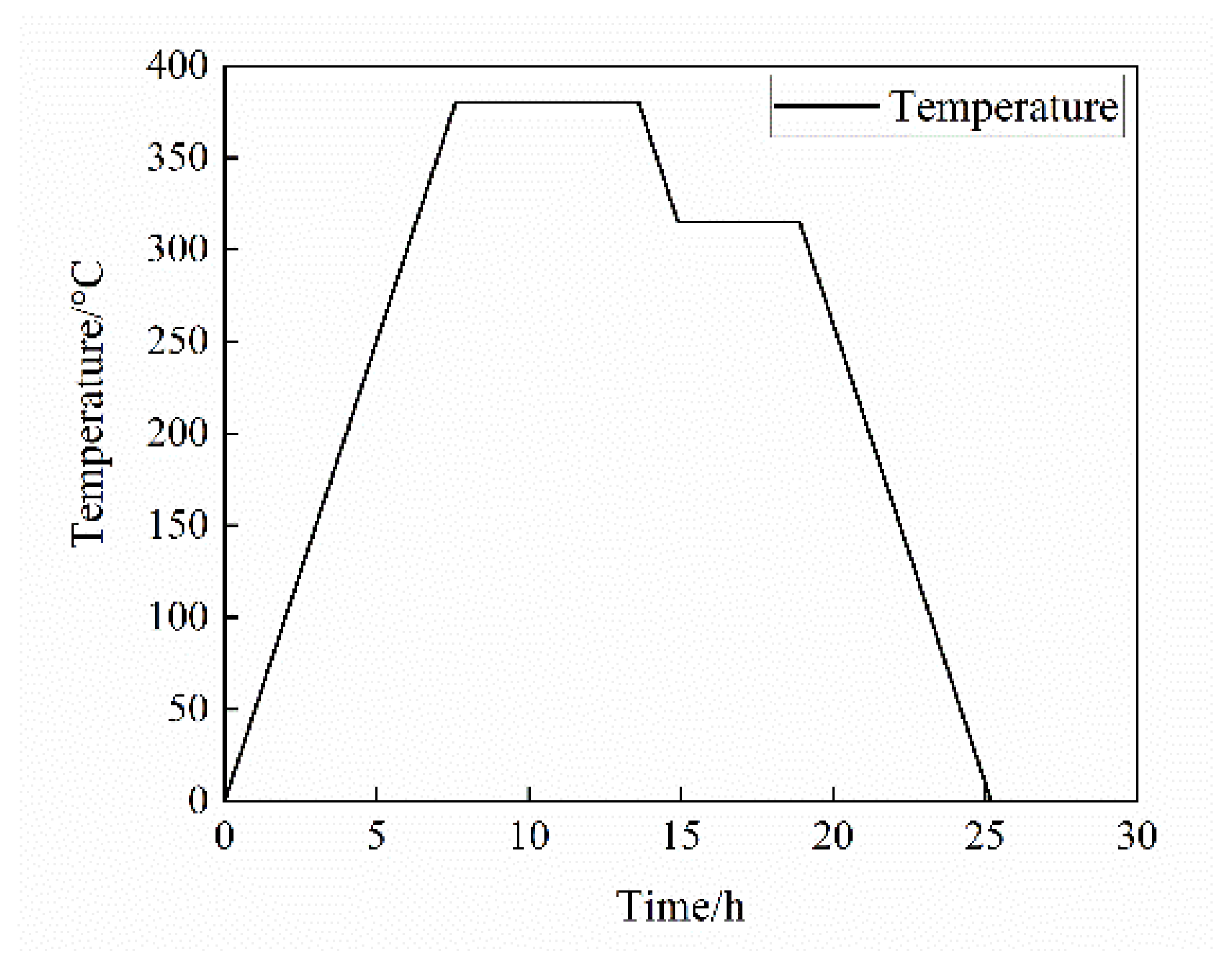
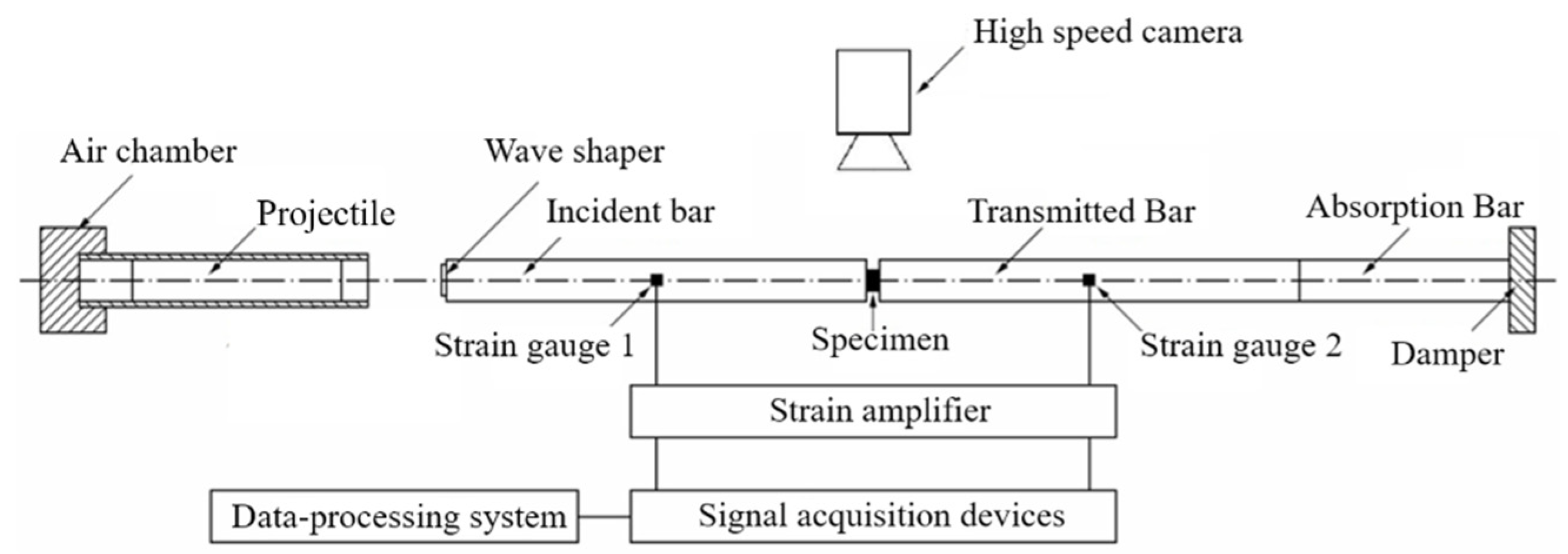


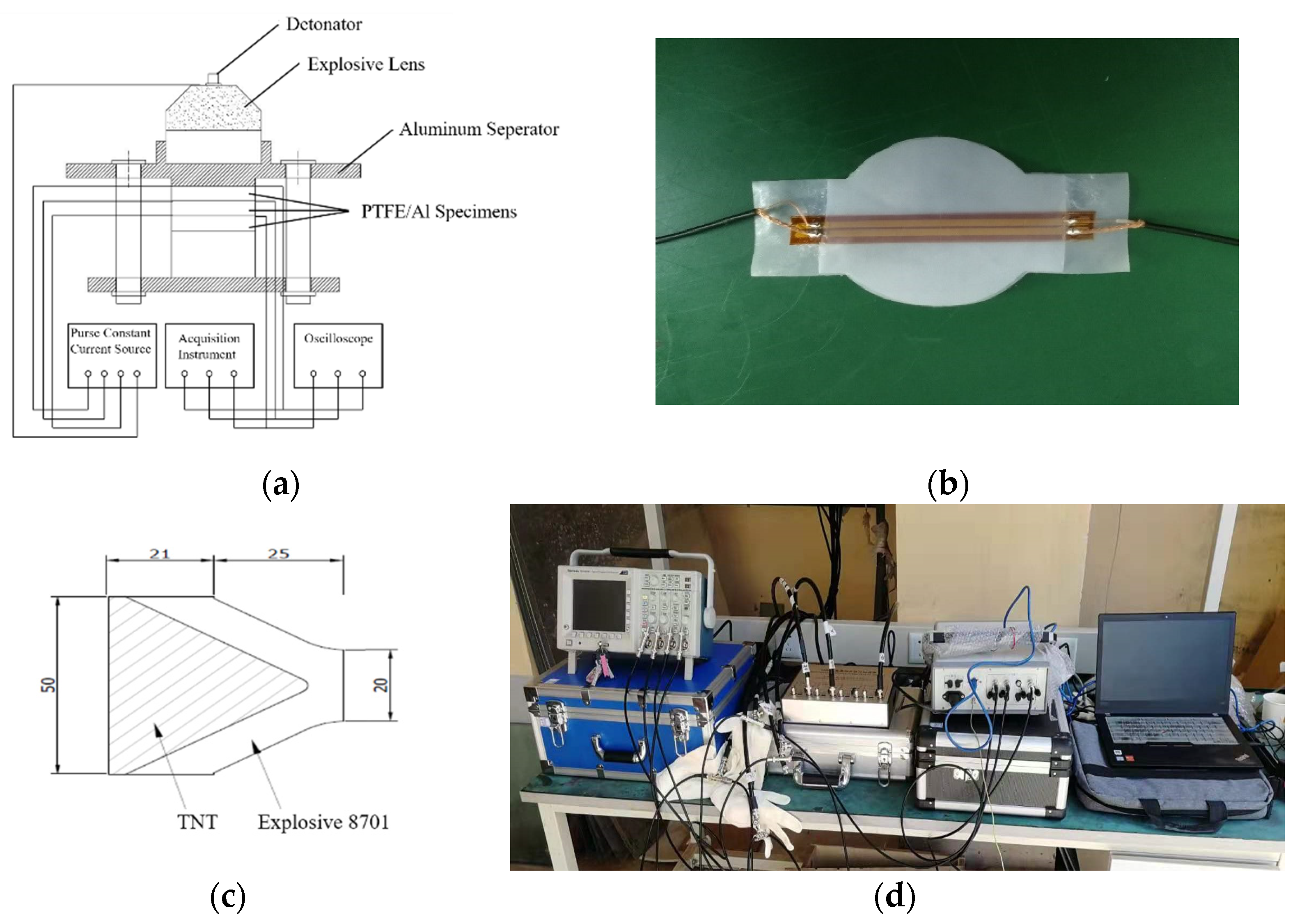
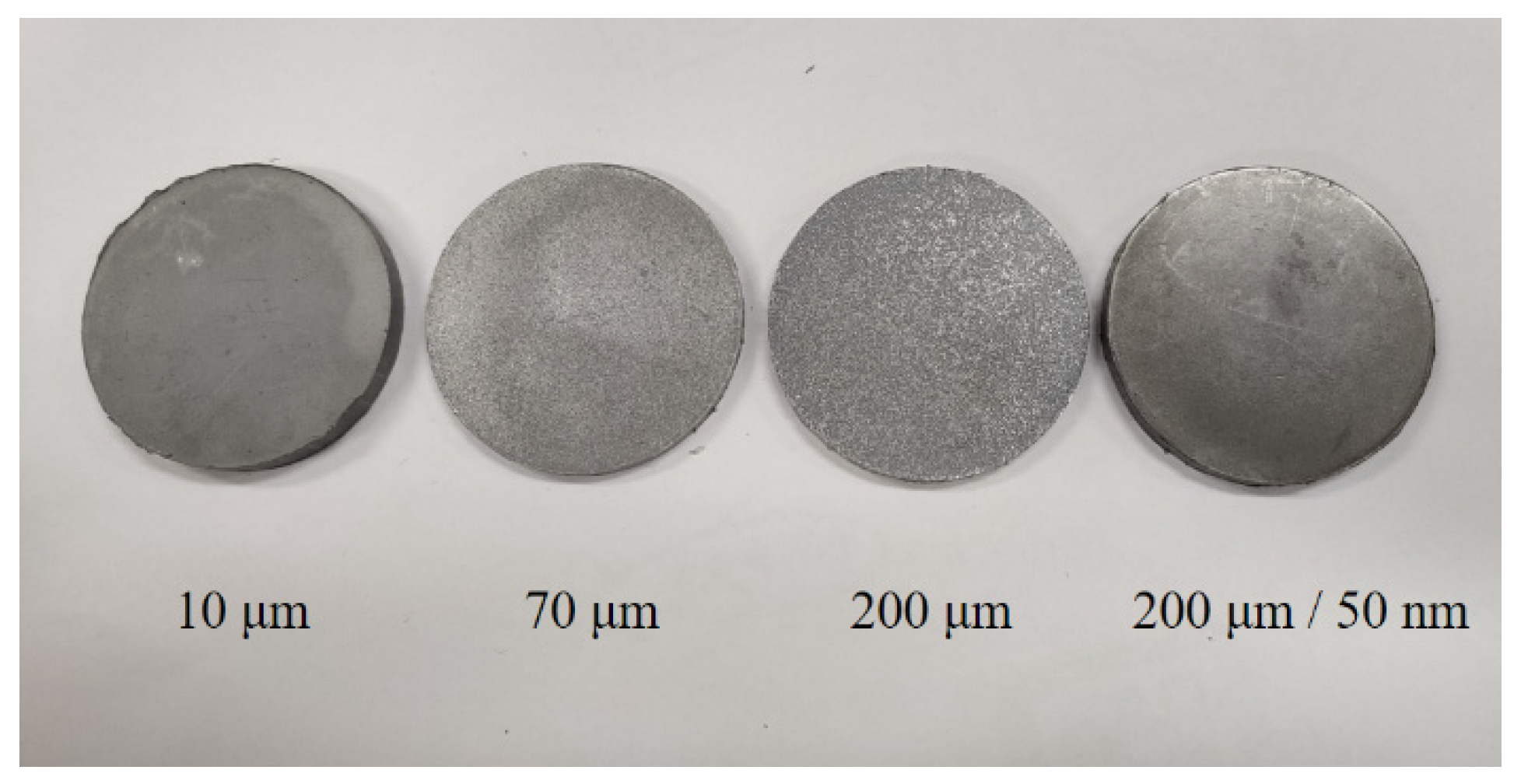
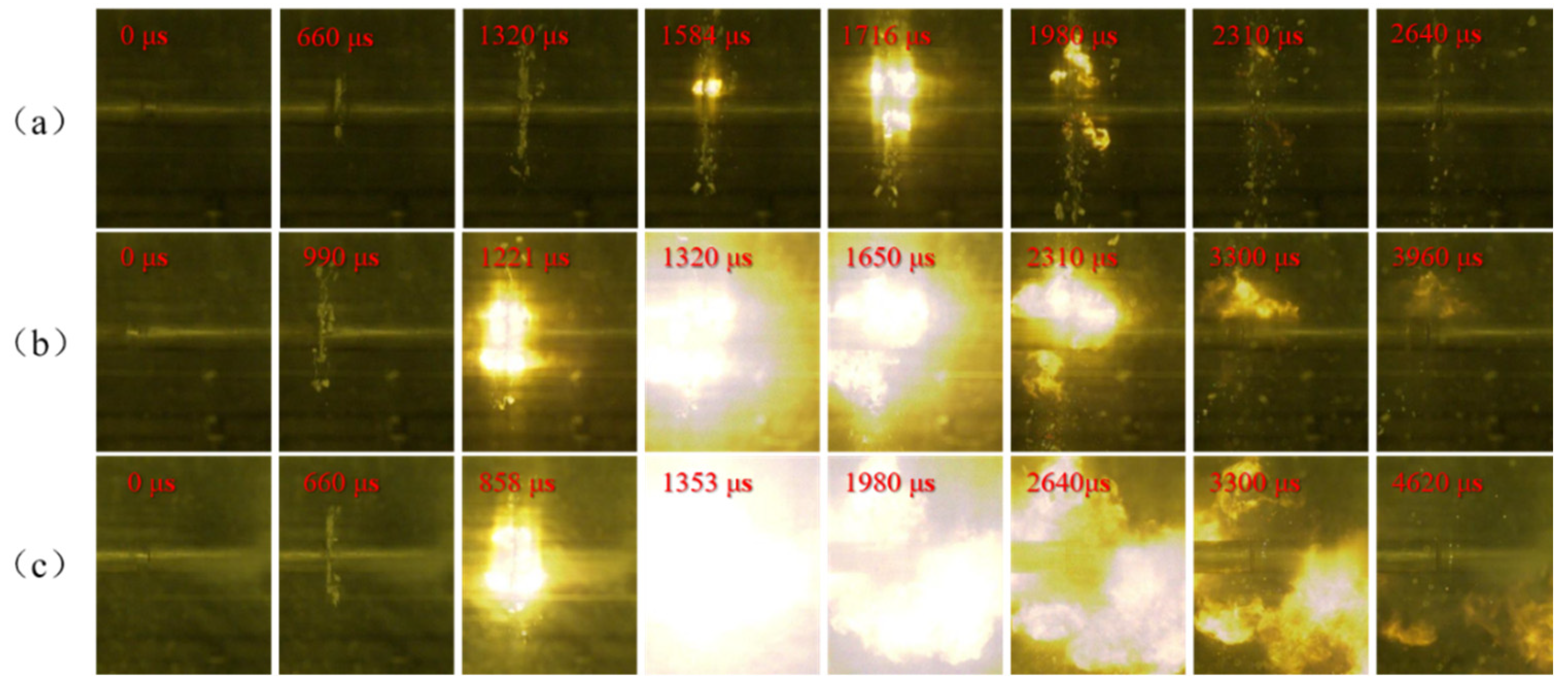
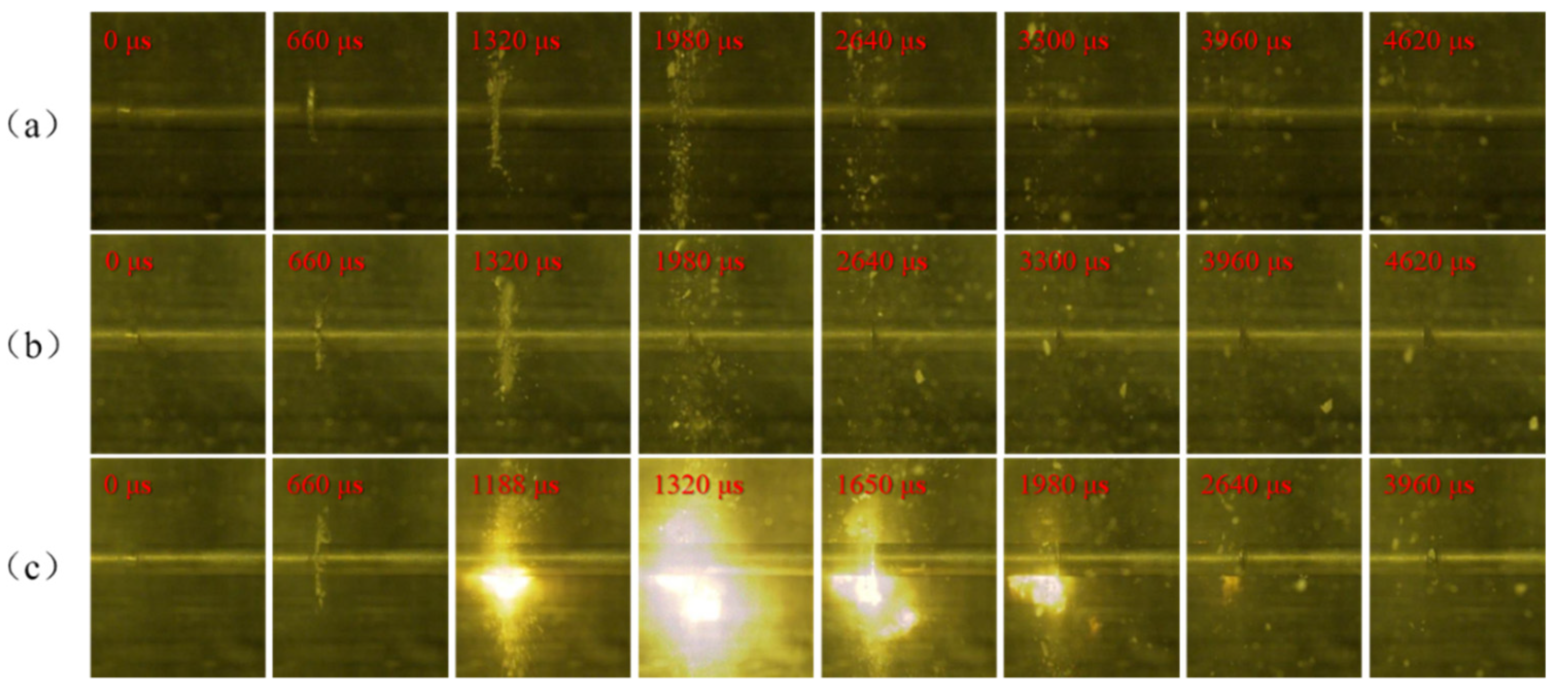
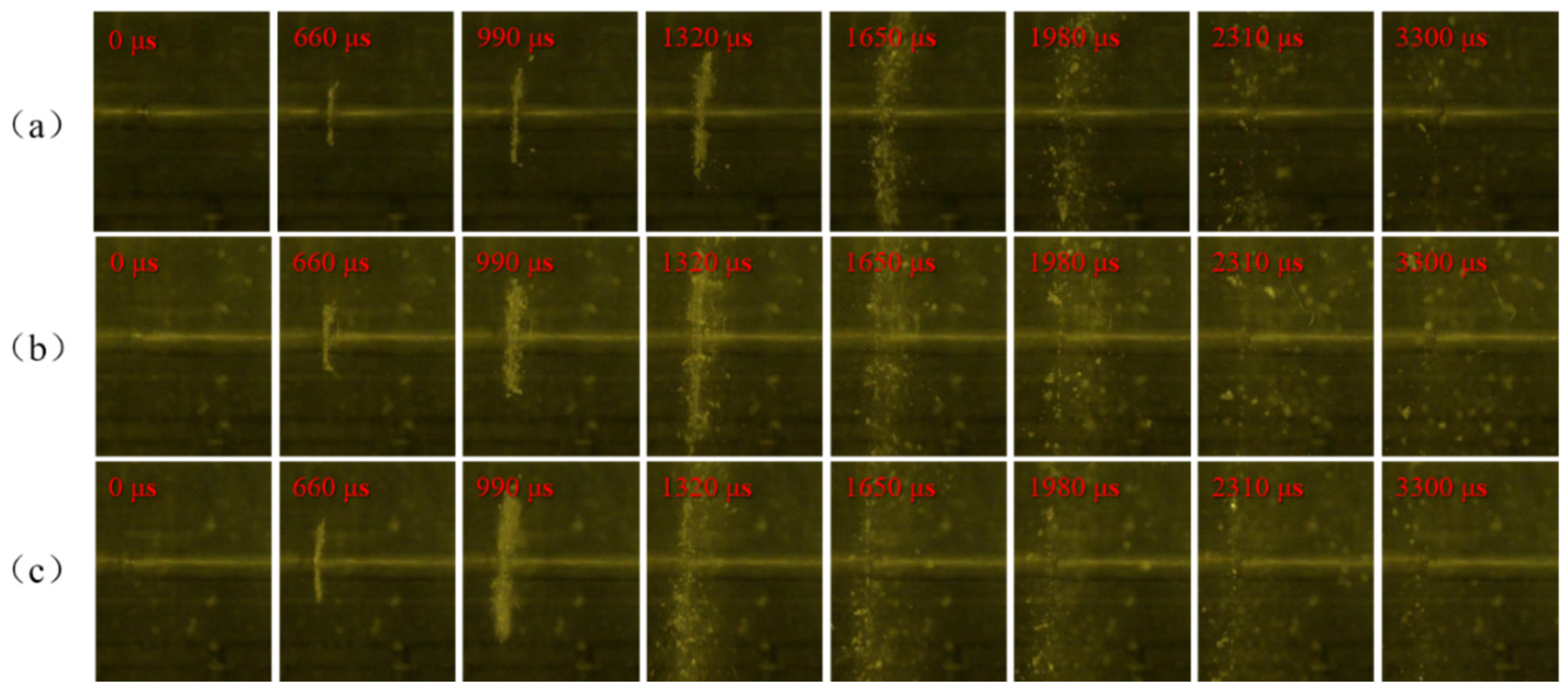
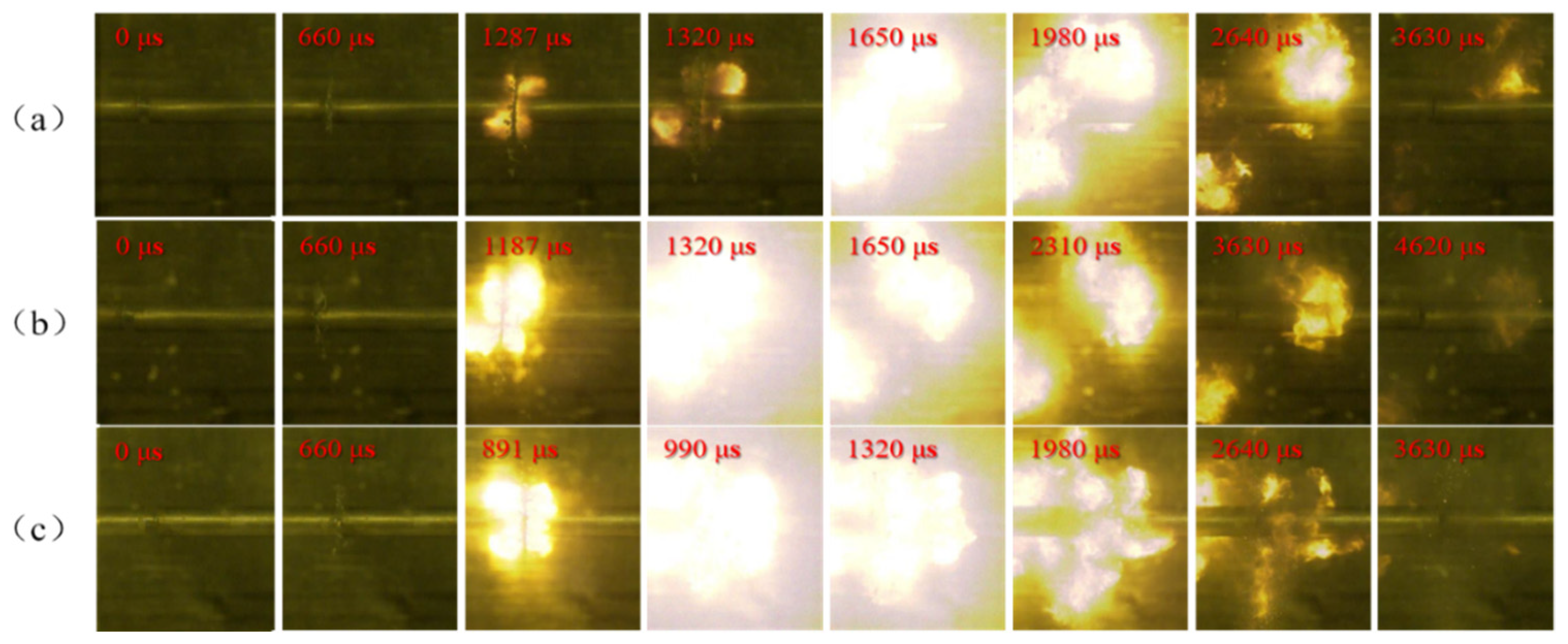

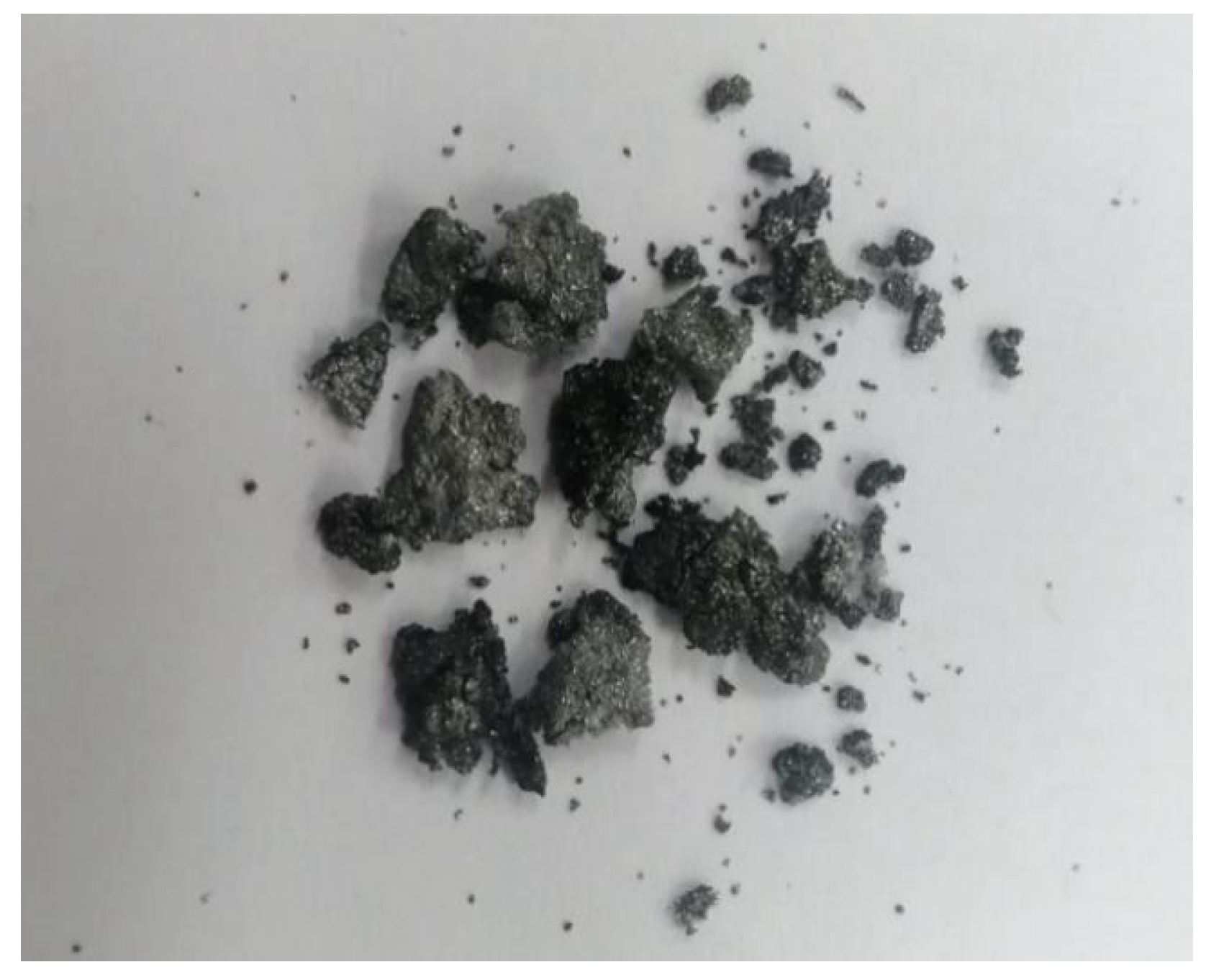


| Number | Al Particle Size | Theoretical Density/(g/cm3) | Actual Density/(g/cm3) | Porosity/(%) |
|---|---|---|---|---|
| 1 | 10 μm | 2.42 | 2402 | 0.8 |
| 2 | 70 μm | 2398 | 0.9 | |
| 3 | 200 μm | 2395 | 1.0 | |
| 4 | 200 μm/50 nm | 2385 | 1.4 |
| Al Particle Sizes | Strain Rate/(s−1) | Ignition Delay/(μs) | Reaction Duration/(μs) |
|---|---|---|---|
| 10 μm | 4176 | 1584 | 957 |
| 4453 | 1221 | 2739 | |
| 5088 | 858 | 3564 | |
| 70 μm | 3958 | unreacted | - |
| 4381 | unreacted | - | |
| 5158 | 1155 | 1782 | |
| 200 μm | 4027 | unreacted | - |
| 4492 | unreacted | - | |
| 5065 | unreacted | - |
| Al Particle Sizes | Peak Pressure of Shockwave/(GPa) | Ignition Delay/(μs) | Value of Pressure Rebound/(GPa) |
|---|---|---|---|
| 10 μm | 13.4 | 2.5 | 1.3 |
| 11.7 | 2.9 | 5.4 | |
| 9.3 | 1.6 | 2.6 | |
| 70 μm | 15.8 | 2.0 | 2.1 |
| 15.4 | 1.7 | 2.3 | |
| 11.0 | 1.9 | 1.8 | |
| 200 μm | 15.8 | 2.2 | 2.1 |
| 9.6 | 1.2 | 1.1 | |
| 9.5 | - | - | |
| 200 μm/50 nm | 15.0 | 1.8 | 1.4 |
| 12.6 | 1.2 | 3.2 | |
| 11.0 | 1.2 | 2.4 |
Publisher’s Note: MDPI stays neutral with regard to jurisdictional claims in published maps and institutional affiliations. |
© 2021 by the authors. Licensee MDPI, Basel, Switzerland. This article is an open access article distributed under the terms and conditions of the Creative Commons Attribution (CC BY) license (https://creativecommons.org/licenses/by/4.0/).
Share and Cite
Mao, L.; Wei, C.; Hu, R.; Hu, W.; Luo, P.; Qi, Y.; Jiang, C. Effects of Al Particle Size on the Impact Energy Release of Al-Rich PTFE/Al Composites under Different Strain Rates. Materials 2021, 14, 1911. https://doi.org/10.3390/ma14081911
Mao L, Wei C, Hu R, Hu W, Luo P, Qi Y, Jiang C. Effects of Al Particle Size on the Impact Energy Release of Al-Rich PTFE/Al Composites under Different Strain Rates. Materials. 2021; 14(8):1911. https://doi.org/10.3390/ma14081911
Chicago/Turabian StyleMao, Liang, Chenyang Wei, Rong Hu, Wanxiang Hu, Puguang Luo, Yuxuan Qi, and Chunlan Jiang. 2021. "Effects of Al Particle Size on the Impact Energy Release of Al-Rich PTFE/Al Composites under Different Strain Rates" Materials 14, no. 8: 1911. https://doi.org/10.3390/ma14081911






